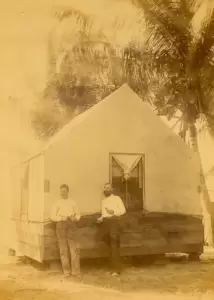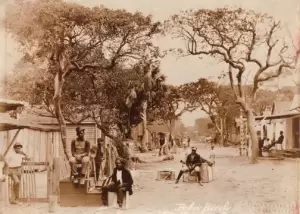The Styx

During construction of the Royal Poinciana Hotel, laborers came from all over, such as Joseph Borman from Michigan. He and a friend arrived when the Royal Poinciana was almost finished, but they had a letter of introduction to entrepreneur Elisha Dimick, who gave them work: “He told us where we could buy a tent, picked out a spot where there was a tent colony. … It was just a lane at the time. … I think there was [sic] six tents there altogether—some workmen’s tents for engi-neers, workmen, and so forth.”

This temporary camp, where Seaview Avenue is today, accommodated only white men. Flagler’s black labor force, including many Caribbeans and former slaves from northern states, formed a settlement called the “Styx,” centered at today’s Sunset and Sunrise avenues off of North County Road. After Flagler’s hotels were completed, the Styx location remained convenient for the employees of those hotels and of the residents of the houses that followed. The Styx population built mostly rough shacks for their dwellings and businesses, although some structures were more substantial. In 1894 one of the churches established there, Tabernacle Missionary Baptist, moved across Lake Worth to Clematis Street and Tamarind Avenue and was approved for use as the first all-black school in Dade County.

The Styx has been said to have housed more than 2,000 African Americans, but the 1900 U.S. Census lists about 100 individuals as “Black” living on Lake Worth outside of the City of West Palm Beach; addresses were not recorded at that time. The 1910 Census shows about 350 people as “Black” or “Mulatto” in the lake area (excluding Jupiter and the City of West Palm Beach), after many had left the Styx; the total Palm Beach County population was then 5,577. Seasonal labor may have added many more temporary residents over the years, but the Styx population probably stayed below 200 residents at one time.
Thomas Peppers
Thomas Peppers lived in the Styx and collected the land rent of $3.00 per month for one of the landlords, James M. Munyon. Having arrived in the 1880s, Peppers was one of the earliest African Americans to live on Lake Worth. He helped to build the FEC Railway, and worked for Elisha Dimick as a rent collector in the Styx and laborer. In the early 1900s, Peppers ran a wheelchair, then the tourists’ preferred mode of transportation, from the Palm Beach Hotel. His wife, neé Priscilla Robinson, also worked for Dimick, and raised four daughters. For the oldest, Inez Peppers Lovett, a childhood in the Styx brought to mind one paved street, dirt lanes, and a church.



